|

 Labyrinths:
Labyrinths:
The word 'Labyrinth' is a pre-Greek word
(Minoan). There is a hidden irony in the current definition and
the original myth of Theseus and the Minotaur's lair, within which one
could get lost in forever. Unlike a maze, which refers to a complex branching puzzle with
choices of path and direction; the 'classic' labyrinth
design has only a single, non-branching path, which
leads to the centre. A labyrinth in this sense has a single,
unambiguous route to the centre and back and is not designed to
be difficult to navigate, so Theseus would have had little need
for Ariadne's thread.
We do not know
when the labyrinth structure first was conceived, but
there are several incidences among the ideograms carved into rock faces across
Neolithic and 'Bronze-age' Europe. We see the ideogram later on
an Etruscan vase from c. 550 B.C. Later, at about 300 B.C., it was used on coins in Crete.
During the middle-ages, it was used in European Cathedrals for
pilgrimage.
The Labyrinth as a Spiritual
Tool.
A labyrinth is an
archetype with which we can have a direct experience. We can
walk it. It is a metaphor for life's journey. It is a symbol
that creates a sacred space which leads us into its heart, then
back out again along the same path. Although one is able to
cross the lines at any time, we are compelled to follow the
meandering path to the centre and back again.
The Labyrinth
represents both a journey to our own centre and back out again
into the world... at the same time as acting as a metaphor for
the path we walk throughout our lives.
There is no
getting lost in a Labyrinth. Rather, one is offered a path that
weaves back and forth, in and out, until it ends in a central
circular area. Here, walkers pause to reflect before departing
as they came, carrying back wisdom gained on the inbound
journey. Labyrinth walkers say the certitude of the path�knowing
all decisions about direction have been made�frees them to focus
on contemplation instead of navigation. Some call this prayer;
others, deep reflection. Whatever the name, the practice has
been used to nourish the soul around the world for several
thousand of years.
The Labyrinth
is a powerful geometric symbol with which we have formed an
almost symbiotic relationship, which allows us to enter within
its physical form at the same time as entering into a
non-physical communication with ourselves.
Because they
are so ancient, the various interpretations of the Labyrinth
today may not agree with the same concept of the labyrinths in
ancient times. It is curious then that the same identical symbol
is found in countries and major religious traditions from around
the ancient world (such as India, France, Egypt, Scandinavia,
Crete, Sumeria, America, the British Isles, and Italy), and that
in all cases, they share a common theme of pilgrimage and
spiritual reward. This has led some claim they represent a
universal pattern in human consciousness.
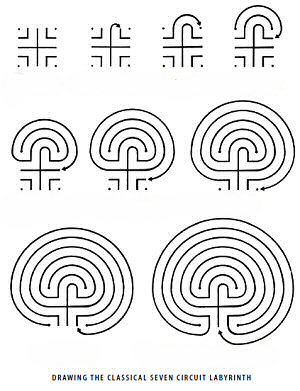
The Geometry of the 'classic'
7-circuit Labyrinth
All 'classic' labyrinths are based on a simple
geometric template.
The ancient
seven-circuit labyrinth (so called because the path creates
seven concentric rings around the centre) is rich with
symbolism. It draws on the mystical quality of the 7, a number
of transformation and vision. In medieval times, the seven
circuits were seen to correspond to the seven visible planets,
and a walk in the labyrinth was a cosmic journey through the
heavens. The seven circuits can also be seen to represent the
days of the week, the chakras, colours, or musical tones.
Some research
suggests that the geometric shape [of a labyrinth] produces an
energy field that can heal ailments of the body and calm the
mind. It balances thoughts with the presence of the body to the
point where one stops thinking and the intuition of knowingness
takes over (4)
Proto Labyrinths..?
Prehistoric
labyrinths have also been found carved on rock faces at Pontevedra,
Spain and at Val Camonica in northern Italy, these latter ones are
attributed to the late Bronze Age. The Rocky Valley labyrinths in
Cornwall, England, are supposed to be from the Bronze Age. The
labyrinth is found etched into the sands of the Nazca Plain in Peru,
in use among the Caduveo people of Brazil and scratched on boulders
and rockfaces in Northern Mexico, New Mexico and Arizona.
It is suggested
that the Labyrinth evolved from the spiral.
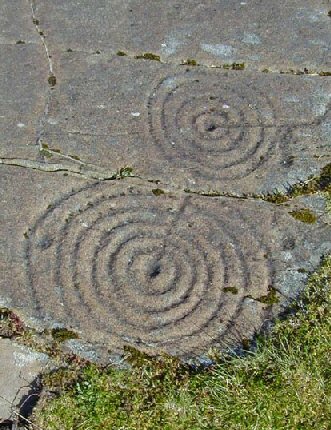
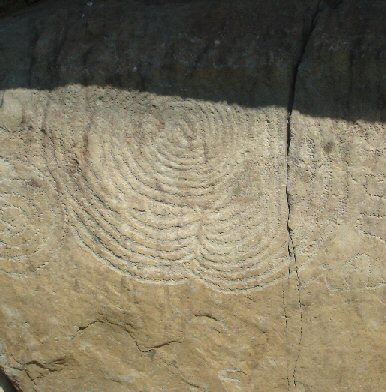
Achnabreck,
Scotland (left), and Knowth, Ireland
(Right).
The Glastonbury Labyrinth:
It is proposed that the strong
terracing on the sides of the Tor represent a classic '7-circuit
labyrinth' in three dimensional form.
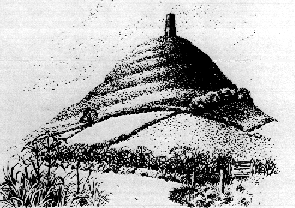
 
The Tor is a natural
hill, but it has been established that it was altered in shape from
the late Neolithic onwards. Whether or not the terraces were cut to
replicate the 'classic' Labyrinth shape is still conjectural but the
location, and the tor's reputation as the 'Sacred Heart of England'
makes it possible that the terraces were the final part of a pilgrim
route.
(More
about Glastonbury Tor)
The 'Lost'
Labyrinth of Egypt.

Herodotus (c.
484-424 BC) describes his visit to the now 'lost' labyrinth after
describing how the Egyptians divided the land into twelve parts, or
nomes, and set a king over each, he says that they agreed to
combine together to leave a memorial of themselves. They constructed
the Labyrinth, just above Lake Moeris, and nearly opposite the city
of crocodiles (Crocodilopolis). "I found it," he says, "greater than
words could tell, for, although the temple at Ephesus and that at
Samos are celebrated works, yet all of the works and buildings of
the Greeks put together would certainly be inferior to this
labyrinth as regards labour and expense." Even the pyramids, he
tells us, were surpassed by the Labyrinth. "It has twelve covered
courts, with opposite doors, six courts on the North side and six on
the South, all communicating with one another and with one wall
surrounding them all. There are two sorts of rooms, one sort above,
the other sort below ground, fifteen hundred of each sort, or three
thousand in all." He says that he was allowed to pass through the
upper rooms only, the lower range being strictly guarded from
visitors, as they contained the tombs of the kings who had built the
Labyrinth, also the tombs of the sacred crocodiles. The upper rooms
he describes as being of super-human size, and the system of
passages through the courts, rooms, and colonnades very intricate
and bewildering. The roof of the whole affair, he says, is of stone
and the walls are covered with carvings. Each of the courts is
surrounded by columns of white stone, perfectly joined. Outside the
Labyrinth, and at one corner of it, is a pyramid about 240 feet in
height, with huge figures carved upon it and approached by an
underground passage.
Strabo, who lived
about 400 years after Herodotus also described them first hand.
After referring to the lake and the manner in which it is used as a
storage reservoir for the water of the Nile, he proceeds to describe
the Labyrinth, "a work equal to the Pyramids." He says it is "a
large palace composed of as many palaces as there were formerly
nomes. There are an equal number of courts, surrounded by
columns and adjoining one another, all in a row and constituting one
building, like a long wall with the courts in front of it. The
entrances to the courts are opposite the wall; in front of these
entrances are many long covered alleys with winding
intercommunicating passages, so that a stranger could not find his
way in or out unless with a guide. Each of these structures is
roofed with a single slab of stone, as are also the covered alleys,
no timber or any other material being used." If one ascends to the
roof, he says, one looks over "a field of stone." The courts were in
a line, supported by a row of twenty-seven monolithic columns, the
walls also being constructed of stones of as great a size. "At the
end of the building is the royal tomb, consisting of a square
pyramid and containing the body of Imandes." Strabo says that
it was the custom of the twelve nomes of Egypt to assemble, with
their priests and priestesses, each nome in its own court,
for the purpose of sacrificing to the gods and administering justice
in important matters.
(More
about the 'Lost' Labyrinth of Egypt)
The Minoan Labyrinth,
Crete:
In Greek
mythology, the Labyrinth was an elaborate structure designed and
built by the legendary craftsman Daedalus for King Minos of
Crete at Knossos to conceal the Minotaur.
'At that
time there reigned at Knossos, in Crete, a monarch called Minos,
who held sway over what was then the most powerful maritime
state in the Mediterranean. Minos had a son named Androgeos,
who, during his travels in Attica, was treacherously set upon
and slain, or so his father was informed. In consequence of this
Minos imposed a penalty on the Athenians in the form of a
tribute to be paid once every nine years, such tribute to
consist of seven youths and seven maidens, who were to be
shipped to Knossos at the appointed periods.
There was at
the court of Minos an exceedingly clever and renowned artificer
or engineer, Daedalus by name, to whom all sorts of miraculous
inventions are ascribed. This Daedalus had devised an ingenious
structure, the "Labyrinth," so contrived that if anybody were
placed therein he would find it practically impossible to
discover the exit without a guide.
The
Labyrinth was designed as a dwelling for, or at any rate was
inhabited by, a hideous and cruel being called the Minotaur, a
monstrous offspring of Queen Pasipha�, wife of Minos. The
Minotaur is described as being half man and half bull, or a man
with a bull's head, a ferocious creature that destroyed any
unfortunate human beings who might come within its power.
According to report, the youths and maidens of the Athenian
tribute were periodically, one by one, thrust into the
Labyrinth, where, after futile wanderings in the endeavour to
find an exit, they were finally caught and slain by the
Minotaur'. (1)
There are many
versions of the legend, some of them greatly at variance with
others. For instance, Philochorus, an eminent writer on the
antiquities of Athens, gives in his "Atthis" a very rationalistic
account of the affair, stating that the Labyrinth was nothing but a
dungeon where Minos imprisoned the Athenian youths until such time
as they were given as prizes to the victors in the sports that were
held in honour of his murdered son. He held also that the monster
was simply a military officer, whose brutal disposition, in
conjunction with his name, Tauros, may have given rise to the
Minotaur myth.

These 5th - 3rd
century BC coins from Knossos were struck with the labyrinth
symbol. The predominant labyrinth form during this period is the
simple 7-circuit style known as the classical labyrinth.
(More
about Knossos, Crete)
The Nazca Labyrinth:
A five-year
study by British archaeologists has shed new
light on the enigmatic drawings created by
the Nazca people between 100 BC and CE 700
in the Peruvian desert. They discovered an
itinerary so complex they can justify
calling it a labyrinth, and see it as
serving ceremonial progressions.
In the midst
of the study area is a unique labyrinth
originally discovered by Prof Ruggles when
he spent a few days on the Nazca desert back
in 1984. �When I set out along the labyrinth
from its centre, I didn�t have the slightest
idea of its true nature,� Prof Ruggles
explained. �Only gradually did I realize
that here was a figure set out on a huge
scale and still traceable, that it was
clearly intended for walking. Invisible in
its entirety to the naked eye, the only way
of knowing its existence is to walk its 2.7
miles (4.4 km) length through disorienting
direction changes which ended, or began,
inside a spiral formation.
(Link
to Full Article)
�The labyrinth is
completely hidden in the landscape,
which is flat and virtually
featureless. As you walk it, only
the path stretching ahead of you is
visible at any given point.
Similarly, if you map it from the
air its form makes no sense at all.�
�But if you walk
it, discovering it as you go, you
have a set of experiences that in
many respects would have been the
same for anyone walking it in the
past. The ancient Nazca peoples
created the geoglyphs, and used
them, by walking on the ground.
Sharing some of those experiences by
walking the lines ourselves is an
important source of information that
complements the hard scientific and
archaeological evidence and can
really aid our attempts to make
anthropological sense of it.�

This ground shot is taken along the innermost pathway of the labyrinth directly
towards the central mound.
The line widens out towards its terminus, creating a
false perspective that makes it appear parallel as it stretches away into the
distance.
(Photo
Credit: Clive Ruggles)
(More
about The Nazca Lines)
The Labyrinth and the
Church.
Probably the oldest
known example of this nature is that in the ancient basilica of
Reparatus at Orl�ansville (Algeria), an edifice which is
believed to date from the fourth century A.D.
(1)
It measures about 8 ft. in diameter and shows great resemblance to
the Roman pavement found at Harpham and the tomb-mosaic at Susa. At
the centre is a jeu-de-lettres on the words SANCTA ECLESIA,
which may be read in any direction, except diagonally, commencing at
the centre. But for the employment of these words the labyrinth in
question might well have been conceived to be a Roman relic utilised
by the builders of the church to ornament their pavement. Such
pavement-labyrinths, however, with or without central figures or
other embellishments, and of various dimensions and composition, are
found in many of the old churches of France and Italy.

As to the function
and meaning of the old church labyrinths, various opinions have been
held. Some authorities have thought that they were merely introduced
as a symbol of the perplexities and intricacies which beset the
Christian's path. Others considered them to typify the entangling
nature of sin or of any deviation from the rectilinear path of
Christian duty. It has often been asserted, though on what evidence
is not clear, that the larger examples were used for the performance
of miniature pilgrimages in substitution for the long and tedious
journeys formerly laid upon penitents. Some colour is lent to this
supposition by the name "Chemin de J�rusalem." at Chartres (see
below). In the days of the first crusades it was a common practice
for the confessor to send the peccant members of his flock either to
fight against the infidel, or, after the victory of Geoffrey of
Bouillon, to visit the Holy Sepulchre. As enthusiasm for the
crusades declined, shorter pilgrimages were substituted, usually to
the shrine of some saint, such as Our Lady of Loretto, or St. Thomas
of Canterbury, and it is quite possible that, at a time when the
soul had passed out of the crusades and the Church's authority was
on the ebb, a journey on the knees around the labyrinth's
sinuosity's was prescribed as an alternative to these pilgrimages.
Perhaps this type of penance was from the first imposed on those
who, through weakness or any other reason, were unable to undertake
long travels.
This view seems to
rest chiefly on a statement by J. B. F. G�ruzez in his "Description
of the City of Rheims" (1817), to the effect that the labyrinth
which formerly lay in the cathedral was in origin an object of
devotion, being the emblem of the interior of the Temple of
Jerusalem, but G�ruzez quotes no authority for his assertion.
Another explanation, based upon the occurrence of the figures of the
architects or founders in certain of the designs, is that the
labyrinth was a sort of masonic seal, signifying that the pious aim
of the builder had been to raise to the glory of God a structure to
vie with the splendours of the traditional Labyrinth. It is also
said that in some cases the "Chemins" were used for processional
purposes.
Some writers have
held that the labyrinth was inserted in the church as typifying the
Christian's life or the devious course of those who yield to
temptation. Some have thought that it represented the path from the
house of Pilate to Calvary, pointing out that Chateaubriand, in his
"Itin�raire de Paris � J�rusalem," mentioned two hours as the period
which he took to repeat Christ's journey, and that the same time
would be taken in traversing the average pavement labyrinth on the
knees.The use of the labyrinth as a simile for the Christian's life
is shown in a stone inscription in the Museum at Lyons:
(1)
 Chartres,
France: Chartres,
France:
There have been at
least five cathedrals on this site, each replacing an earlier
smaller building that had been destroyed by war or fire. It was
called the 'Church of Saint Mary' in the eighth century.
One of the best
known examples of Cathedral Labyrinths is found at Chartres, in
rance: As well as the huge 11-circuit labyrinth on the floor,
the cathedral has a spectacular rose window over the great west
doors. This has the same dimensions as the labyrinth and is exactly
the same distance up the west wall as the labyrinth is laterally
from the cathedral's main entrance below the window
The labyrinth at Chartres was known as a "Chemin
de J�rusalem" "daedale," or "meandre," terms which
need no explanation. The centre was called "ciel" or "J�rusalem."
(1)
When pilgrimage to
the Holy City of Jerusalem was made difficult and dangerous by the
Crusades. The Church designated seven European cathedrals, mainly in
France, to become �Jerusalem� for pilgrims. The labyrinth became the
final stage of pilgrimage, serving as a symbolic entry into the
Celestial City of Jerusalem. All seven cathedrals used the
11-circuit labyrinth design.
(3)
Other Examples
of Labyrinths from around the Ancient World.
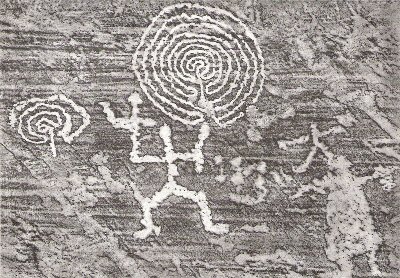
Although it is
difficult to date exactly, this (Neolithic - Early Bronze-age)
labyrinth comes from Val Camonica, in Italy. The Val Camonica
valley has revealed over 300,000 petroglyphs of which this is
just one. It is one of the richest sources of rock-art in all
Europe.
(More
about Val Camonica, Italy)

Reverse of a
clay tablet from Pylos bearing the motif of the Labyrinth. The
tablet, the earliest datable representation of the 7-course
classical labyrinth, was recovered from the remains of the
Mycenaean palace of Pylos, destroyed by fire ca 1,200 B.C. (Kern,
Through the Labyrinth, Prestel, 2000, p. 73, catalog item
103�104).
(More
about Mycenae, Greece)
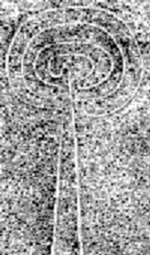
This classic
'3-circuit labyrinth' is one of the many intricate geoglyphs,
or patterns created on the plains northwest of Nazca, Peru,
by the indigenous peoples there, sometime between 200 B.C. and 700
A.D. Native Americans had them, and continue to be used in the
sacred ceremonies of the Hopi. The Hopi Indians called the
labyrinth the symbol for �mother earth� and equated it with the
Kiva (called it Tapu'at, or Mother-child.)
(More
about Nazca, Peru)
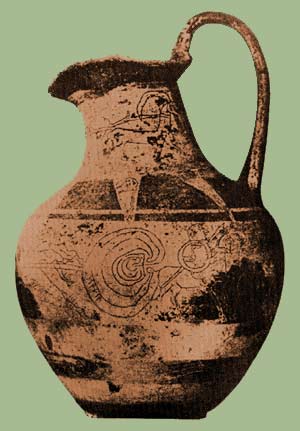
This Etruscan
Vase (c. 550 B.C.) came from Tragliatelli, Italy, with labyrinth
design and three horse-back warriors riding away from it.

Currently the earliest evidence
for the labyrinth in Asia is probably a labyrinth carved amongst
other prehistoric petroglyphs, recently discovered on a
riverbank at Pansaimol in Goa (Kraft, 2005). The age of this
labyrinth is the subject of considerable dispute amongst experts
on Indian rock art, but it could date to the Neolithic period,
maybe c. 2,500 B.C. which would make it as old, if not older, than
similar early labyrinth petroglyphs in Europe. Several examples
of the labyrinth symbol have also been found amongst cave art in
the north of India. One example at Tikla, in Madhya Pradesh, has
been dated to approximately 250 B.C., although doubt remains as
to whether the labyrinth is contemporary with other more
dateable figures (Kern, 2000).
(2)
(Prehistoric
India)
(Knossos,
Greece) (The
'Lost' Labyrinth, Egypt)
(Spirals)
(Sacred
Geometry)
(Altered
Landscapes)
|











 Chartres,
France:
Chartres,
France: 



